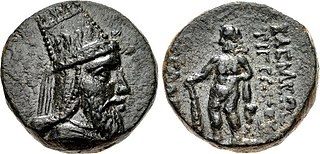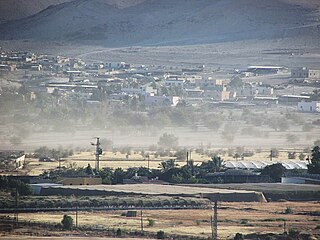
Herod I or Herod the Great was a Roman Jewish client king of the Herodian Kingdom of Judea. He is known for his colossal building projects throughout Judea. Among these works are the rebuilding of the Second Temple in Jerusalem and the expansion of its base—the Western Wall being part of it. Vital details of his life are recorded in the works of the 1st century CE Roman–Jewish historian Josephus.

The Hasmonean dynasty was a ruling dynasty of Judea and surrounding regions during the Hellenistic times of the Second Temple period, from c. 140 BCE to 37 BCE. Between c. 140 and c. 116 BCE the dynasty ruled Judea semi-autonomously in the Seleucid Empire, and from roughly 110 BCE, with the empire disintegrating, Judea gained further autonomy and expanded into the neighboring regions of Perea, Samaria, Idumea, Galilee, and Iturea. The Hasmonean rulers took the Greek title basileus ("king") as the kingdom became a regional power for several decades. Forces of the Roman Republic intervened in the Hasmonean Civil War in 63 BCE and made it into a client state, marking the decline of Hasmonean dynasty; Herod the Great displaced the last reigning Hasmonean client-ruler in 37 BCE.

Antipater I the Idumaean was the founder of the Herodian Dynasty and father of Herod the Great. According to Josephus, he was the son of Antipas and had formerly held that name.

The Tower of David, also known as the Citadel, is an ancient citadel and contemporary museum, located near the Jaffa Gate entrance to the Old City of Jerusalem.

Aretas IV Philopatris was the King of the Nabataeans from roughly 9 BC to 40 AD.

Tigranes V, also known as Tigran V was a Herodian prince who ruled as a Roman client king of Armenia from 6 AD to 12 AD.

The Herodian dynasty was a royal dynasty of Idumaean (Edomite) descent, ruling the Herodian Kingdom of Judea and later the Herodian Tetrarchy as a vassal state of the Roman Empire. The Herodian dynasty began with Herod the Great, who assumed the throne of Judea, with Roman support, bringing down the century-old Hasmonean Kingdom. His kingdom lasted until his death in 4 BCE, when it was divided among his sons and daughter as a tetrarchy, which lasted for about 10 years. Most of those tetrarchies, including Judea proper, were incorporated into Judaea Province from 6 CE, though limited Herodian de facto kingship continued until Agrippa I's death in 44 CE and nominal title of kingship continued until 92 CE, when the last Herodian monarch, Agrippa II, died and Rome assumed full power over his de jure domain.
Phasael, was a prince from the Herodian Dynasty of Judea.

Philip the Tetrarch, sometimes called Herod Philip II by modern writers was the son of Herod the Great and his fifth wife, Cleopatra of Jerusalem. As a Tetrarch, he ruled over the northeast part of his father's kingdom between 4 BCE and 34 CE after Herod's death. He was a half-brother of Herod Antipas and Herod Archelaus. He is not the same person as Herod II, whom some writers call Herod Philip I.

Fasayil or Fasa'il, ancient Phasaelis, is a Palestinian village in the northeastern West Bank, a part of the Jericho Governorate, located 14 kilometres (8.7 mi) northwest of Jericho and about 40 kilometres (25 mi) southeast of Nablus. The closest Palestinian locality is Duma to the west. The village is located 2 km south of the Israeli settlement of Petza'el. According to the 2017 census by the Palestinian Central Bureau of Statistics (PCBS), the village had a population of 1,637.
Gaius Julius Alexander II was a Herodian prince who lived in the 1st century and 2nd century in the Roman empire.
Gaius Julius Agrippa was a Cilician Prince and the first-born son of King Gaius Julius Alexander and Queen Julia Iotapa of Cetis. He had two younger siblings: a brother called Gaius Julius Alexander Berenicianus and a sister called Julia Iotapa.

Petza'el is a moshav and Israeli settlement in the West Bank. Located in the center of the Jordan Valley, 34.5 kilometers from the Green line, it falls under the jurisdiction of Bik'at HaYarden Regional Council. In 2022 it had a population of 371. It is named for Phasael, older brother of Herod the Great, for whom he had named a city nearby in ancient times.

Alexander, son of Herod was born about 35 BC; died about 7 BC. His mother was the Hasmonean princess Mariamne.
Alexander II, also known by his Roman name Gaius Julius Alexander was a Herodian prince.

The Herodian kingdom was a client state of the Roman Republic ruled from 37 to 4 BCE by Herod the Great, who was appointed "King of the Jews" by the Roman Senate. When Herod died, the kingdom was divided among his sons into the Herodian Tetrarchy.

Herod the Great's siege of Jerusalem was the final step in his campaign to secure the throne of Judea. Aided by Roman forces provided by Marcus Antonius, Herod was able to capture the city and depose Antigonus II Mattathias, ending Hasmonean rule. The siege appears in the writings of Josephus and Dio Cassius.

Herod's Palace at Jerusalem was built in the last quarter of the 1st century BC by Herod I the Great, King of Judea from 37 BC to 4 BC. It was the second most important building in Jerusalem, after the Temple itself, in Herod's day and was situated at the northwestern wall of the Upper City of Jerusalem. Herod lived in it as a principal residence, but not permanently, as he owned other palace-fortresses, notably at Masada, Herodium and Caesarea Maritima. Nothing remains of the Jerusalem Palace today except for portions of the surrounding wall-and-tower complex, much altered and generally known as "the Citadel". The site of the former palace is now occupied by the Tower of David Museum, a police station, and a former Turkish barracks/prison known as the Kishle.
Phasael or Pasiel, in Greek sources Phasaelis, was a princess of Nabatea, daughter of King Aretas IV Philopatris and the first wife of Herod Antipas, ruler of Galilee and Perea.
Phasael or Phasa'el is an ancient Semitic, probably mainly Nabataean, gender-neutral name, i.e. used for both men and women.













